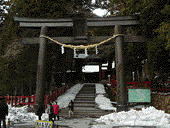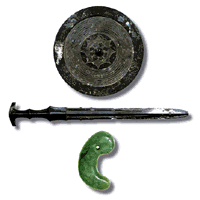Shinto - Japan's Native Religion
 Shinto (literally, the way of the gods) is the native Japanese religion. It originated in prehistoric times and has long played an important role in Japanese society. The major jinja (shrines) around the country have often been power bases, closely tied with Imperial and shogunal powers. Unlike the world's major religions, Shinto has no fixed dogma, moral precepts, or sacred scriptures. Perhaps for this reason, most Japanese quite easily incorporate Shinto into their way of life alongside Buddhism and even elements of Christianity without feeling a strong attachment to or having a passionate belief in any of them. Shinto is practiced at jinja, which are most easily distinguished from Buddhist o-tera (temples) by the distinctive torii gates that mark the entrance (photo).
Shinto (literally, the way of the gods) is the native Japanese religion. It originated in prehistoric times and has long played an important role in Japanese society. The major jinja (shrines) around the country have often been power bases, closely tied with Imperial and shogunal powers. Unlike the world's major religions, Shinto has no fixed dogma, moral precepts, or sacred scriptures. Perhaps for this reason, most Japanese quite easily incorporate Shinto into their way of life alongside Buddhism and even elements of Christianity without feeling a strong attachment to or having a passionate belief in any of them. Shinto is practiced at jinja, which are most easily distinguished from Buddhist o-tera (temples) by the distinctive torii gates that mark the entrance (photo).
Shinto followers worship a huge array of kami (gods or spirits) which personify all aspects of nature, such as the sky, the earth, heavenly bodies, and natural phenomena. Sacred objects, such as rocks or trees, can be recognized by the shimenawa ropes and white paper strips attached to them. Many of the matsuri (festivals) held all over Japan originated from Shinto rites, including prayers of thanksgiving, offerings of food and valuables, and purification rituals.
Early History
The origins of Shinto are hidden in the mists of time. According to the historical chronicles of ancient Japan, the Kojiki (Record of Ancient Matters, AD712) and the Nihon Shoki (Chronicle of Japan, AD720), the sun goddess Amaterasu Omikami presented the sanshu no jingi or Imperial Regalia to her grandson, Ninigi no Mikoto. He in turn passed them on to his descendants, the emperors, the first of whom was Emperor Jimmu. The regalia (see below) are symbols of the legitimacy and authority of the emperor, who was considered to be divine until as late as the end of World War II.
Shinto only received an actual name and became in any way systemized in the late 6th century AD, in order to distinguish it from Buddhism and Confucianism, newly introduced from China. Eager to keep up with their neighbors to the west, the Imperial court adopted Buddhism and many other aspects of Chinese culture and innovation. The emperors also became Buddhist, though Shinto continued to be practiced at court and at a few of the major jinja. The foreign and native religions continued to assimilate for over a thousand years. In the late 8th century, under the great teacher Kukai, Shinto and Buddhism were united as a new doctrine called Ryobu Shinto (the Shinto of two kinds).
Shinto Revival
During the Edo Period (1600-1868) there was a revival of nationalistic sentiments. One result was a resurgent interest in the ancient Shinto beliefs, and the discarding of foreign influences. During the Meiji Restoration of 1868, the emperor was restored to the head of the government and Shinto was established as the state religion. The emperor was considered the divine descendant of the sun goddess. This direct lineage from the gods was reflected in a feeling of Japanese superiority, which in turn fed the military expansion of the Japanese Empire. State Shinto was considered the official belief of the entire Japanese race and was embodied in the huge number of jinja, large and small, throughout the country. The great jinja are Meiji Jingu and Yasukuni Jinja in Tokyo, Ise Jingu in Ise, and Izumo Taisha in Matsue. Sectarian Shinto was divided up into many sects, which can be grouped into five main categories, based on: traditional Shinto, Confucianism, faith healing, mountain worship, and purification rites.
 The sanshu no jingi, or Imperial Regalia (right) are holy relics which appear in Japan's ancient myths. They are the symbols of the legitimacy and authority of the emperor.
The sanshu no jingi, or Imperial Regalia (right) are holy relics which appear in Japan's ancient myths. They are the symbols of the legitimacy and authority of the emperor.
In order of importance, they consist of the sacred mirror (yata no kagami, stored at Ise Jingu), the sacred sword (kusanagi no tsurugi, stored at Atsuta Jingu in Nagoya) and the curved jewels (yasakani no magatama, kept at the Imperial Palace in Tokyo). The original sacred sword was lost at the famous Battle of Dannoura in 1185.
According to the myth, the sun goddess Amaterasu Omikami was driven to hide herself in a cave by the boisterous behavior of her younger brother, Susanoo no Mikoto, god of the oceans. The sacred mirror was used to lure her from her hiding place. When she emerged, the deities of heaven presented her with the sacred jewels. The sword was removed from the tail of a serpent by Susanoo and presented to his sister as a sign of his submission.
Modern Shinto
After World War II, the Allied Occupation separated Shinto and the state and this break was written into the new constitution. So visits by leading politicians to Yasukuni Jinja, which enshrines the Japanese war-dead, are always protested as being provocative by Japan's Asian wartime foes. The emperor issued a statement renouncing all claims to divinity, and the use of Shinto symbols for nationalistic purposes was forbidden. Even today, protests against these and other changes are a favorite rallying call of right-wing extremists.
In addition to the hundreds of festivals, many Shinto ceremonies play an important part in modern daily life. Many marriages are carried out in jinja, building plots are purified and sometimes even new cars are blessed for safety. In a rite called oharai, the white-clad priest waves a stick with white strips of paper attached to carry out the blessing. Most family homes have a kamidana (god shelf) as well as a Buddist butsudan (Buddha altar). The main teaching centers for Shinto priests are Kokugakuin University in Tokyo and Kogakukan University in Ise.
(One of the most authoritative works on the subject is Shinto: The Way of Japan (1965) by the American educator and clergyman Floyd H. Ross)
Related content:
Links
- An excellent (and much more insightful than mine!) introduction to what exactly Shinto is can be read here.
